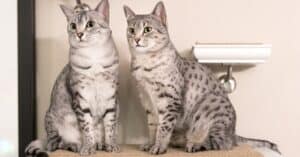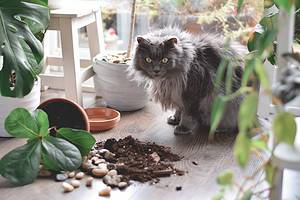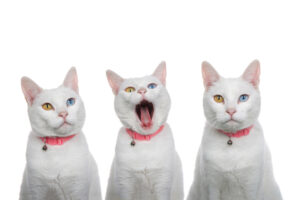The Bengal cat vs. the British shorthair cat. You have likely heard of each of them, but do you know how they are alike and different? The cat in this article’s main photo above is a Bengal.
These breeds are both medium to large-sized cats with short fur coats. Cat fanatics around the world love each of these breeds dearly. Hundreds of thousands of these cats live the good life in homes with doting paw-rents. Both cat breeds enjoy time spent with their human families.
The Bengal cat makes the top 10 best cats list at number four. The British shorthair doesn’t make this list at all. Let’s explore all the other differences between Bengal cats versus British shorthair cats!
Bengal Cat vs. British Shorthair Cat: Appearance
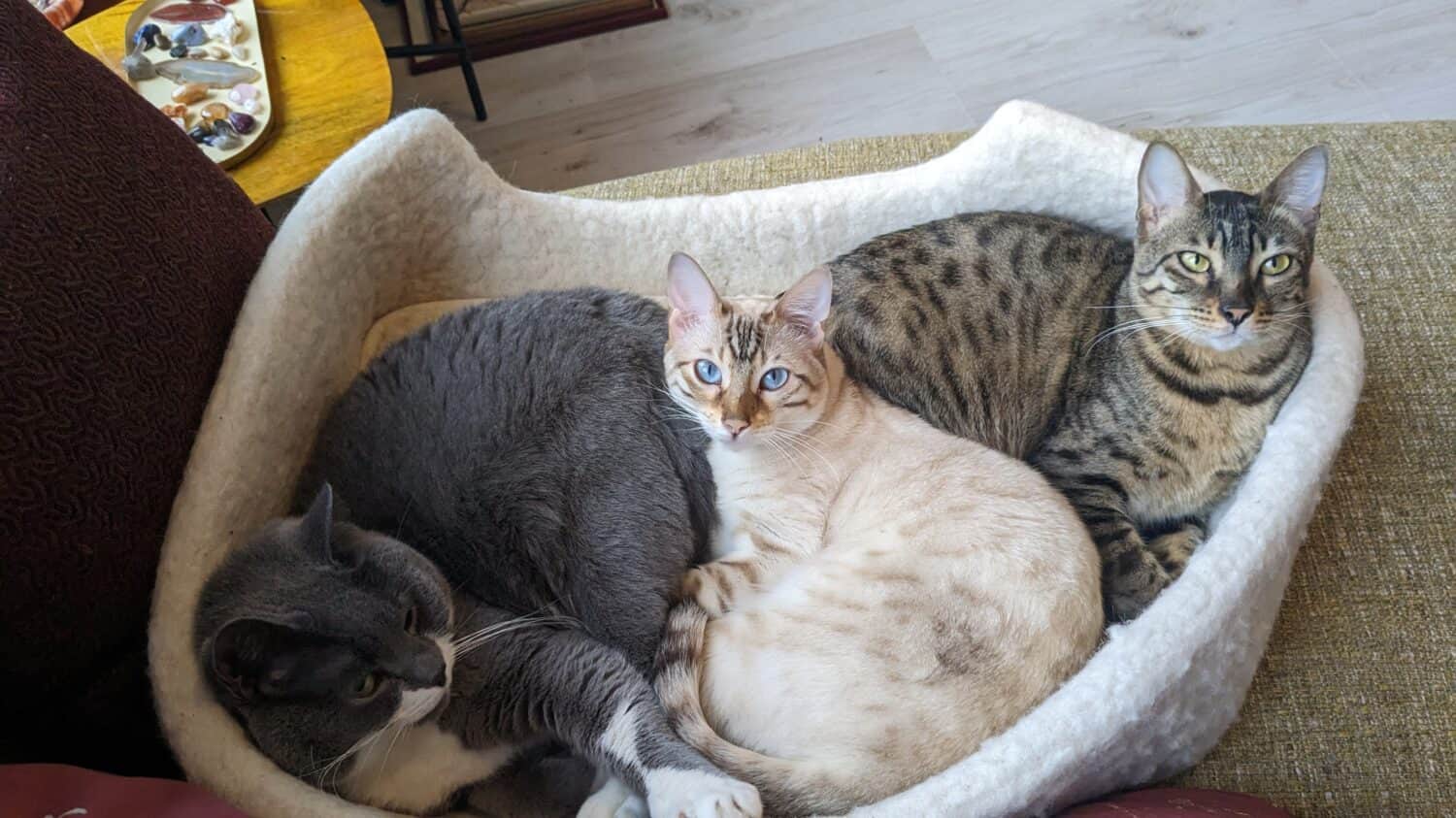
From left to right, pictured are a British shorthair, a spotted snow Bengal, and a spotted Savannah cat.
©Arwen Matthijssen/Shutterstock.com
The easiest difference to see between these two cat breeds is their appearance. They look nothing alike!
Bengal Cat Appearance
Bengal cats (Bengals) have sleek, short coats that sport leopard spots or a marble pattern. They do not shed much and need very little grooming. Bengals have large, round eyes and small to medium, rounded ears. They have large whisker pads, and their heads are egg-shaped when you look from the side. They have long, muscular legs and short tails that do not taper. Bengals have blue, green, aqua, or gold eyes, which correspond to their coat color. Their coats can be almost any color, though some colors are rarer than others. Brown spotted is the most common Bengal color. The striking, wild look of a Bengal cat is why most people get excited by them. A similar wild-looking cat breed is the Savannah cat.
British Shorthair Cat Appearance
British shorthair cats (or BSH or Brits) have thick, plush coats with or without a pattern. Their coat requires brushing to remove loose, dead hairs but rarely tangles or mats. They come in a variety of colors. From calico (black, red, and white) to brown tabby to solid white, but the most common color for them is solid blue. Brits also have big, round eyes that come in either copper, green, or blue. Their eye color is also related to coat color. Copper eyes are the most desirable. Every part of this breed is round. Round face, round eyes, round stubby legs, round chubby cheek, round ears, and rounded tail tip. The roundness of the cheeks often reminds people of the Cheshire Cat and his smile. The gentle teddy bear-like look of these cats is what makes them so cuddly and lovable. A similar-looking cat breed is the Chartreaux.
Bengal Cat vs. British Shorthair Cat: Personality
These cats may be similar in size, but they have completely different personalities. One is high-energy, and the other is quite lazy!
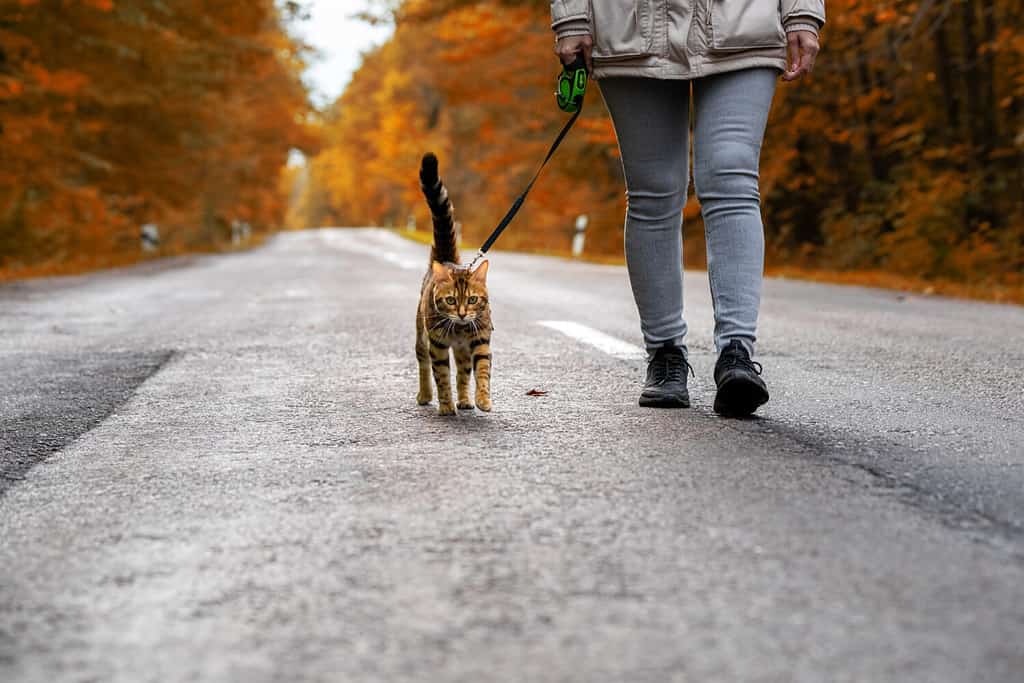
Some Bengal cats enjoy walks with their owners.
©Amerigo_images/Shutterstock.com
Bengal Cat Personality
Known for being the wild child breed, Bengals have a lot of energy. They are very athletic and playful. Even well into their adult years, a Bengal cat will need plenty of time playing to stay happy and healthy. Some records state Bengals can jump 15 feet or more! Many people also take them on walks or even kayaking. Sukii is a Bengal cat dubbed the ultimate adventure cat! Bengals also tend to be very affectionate towards their human companions.
They do not generally like to be picked up or held. They also are likely to get along with other animals in the home. Not only that, but they can be rough when playing. So, they do best with other pets that can handle it. This may also make them a poor choice for families with small children. Bengals thrive on human attention, so leaving them alone for long periods is not advised. These cats demand attention with loud meowing and pawing at their owners. They need a lot of time with their humans to be happy.
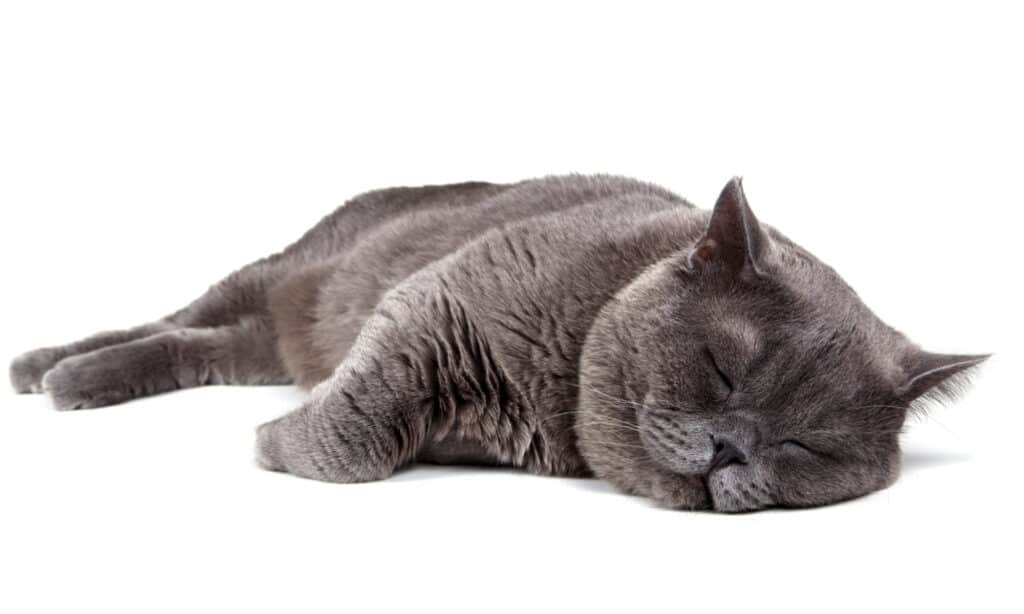
British shorthair cats are often considered lazy.
©Alex Coan/Shutterstock.com
British Shorthair Personality
Known for their laid-back attitudes, British shorthairs’ lazy demeanor is somewhat endearing. They don’t like to be picked up or do a lot of jumping and climbing. It may take some convincing, but Brits will play with toys if they find them enticing enough. They may also have spurts of energy, but they are the happiest when lounging about with their owners. There isn’t much that will irritate a British shorthair, so they make great family cats. They also don’t mind being left alone to go about their uneventful days. They tend to be quiet cats, accepting attention given, though not making a fuss to get it. Puss in Boots, from the movie of the same name, is generally considered to be a British shorthair cat.
Bengal Cat vs. British Shorthair Cat: History
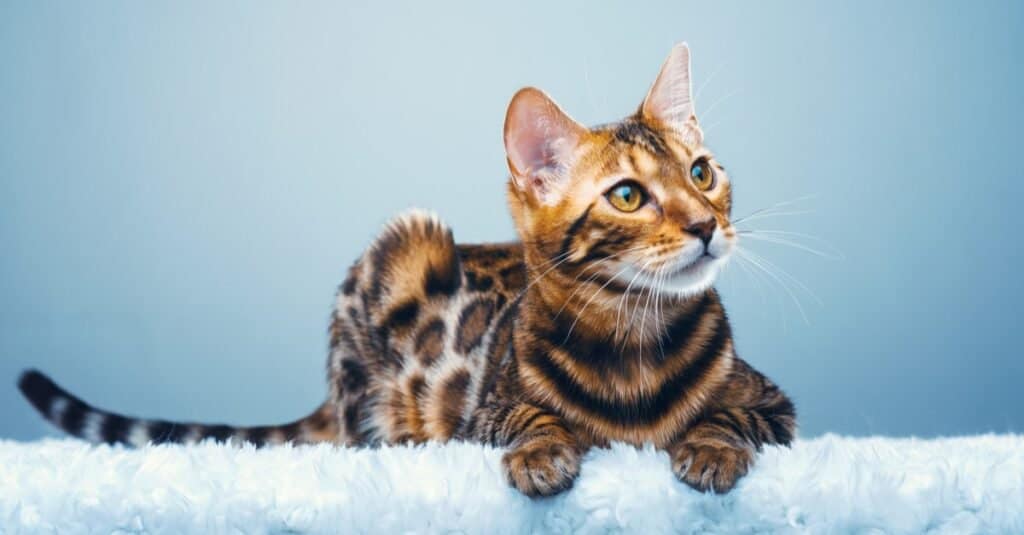
The Bengal cat’s origins start in the 1960s in the United States.
©Cressida studio/Shutterstock.com
Both of these breeds have interesting, albeit very different, histories. Each took dedicated people to turn them into the breed we know and love today!
Bengal Cat History
Bengal cats began in the 1960s in the United States as an experiment. This breeding between an Asian leopard cat and a domestic cat resulted in spotted kittens. Over the next 30 years, they developed into the breed we know today. Dr. Willard Centerwall (of Centerwall Bengals) and Jean Mill (of Millwood Bengals) spearheaded this selective breeding. Millwood and Centerwall are still recognizable names in Bengal pedigrees (family trees) today. Nearly any Bengal breeder you speak to will know of them. Many people credit Mill for creating the breed, but Dr. Centerwall did much of the work before giving her most of his cats in the 1980s. The breed gained popularity quickly, spreading like wildfire throughout the world.
Now, many organizations accept the Bengal breed. These organizations, called registries, host cat shows. The most significant of these is The International Cat Associate (TICA). Many people were afraid of having the cats in the show hall because of their wild ancestry. TICA finally allowed them Championship status in 1991. This only happened after people realized they had nothing to fear. Championship status means gaining the right to compete in shows for titles. TICA accepted the longhaired variant more recently in 2017. The Cat Fancier’s Association (CFA) accepts both shorthair and longhair Bengals.
More than 2,000 registered breeders around the world specialize in Bengal cats. Up to 1,200,000 of these cats exist on our planet today. As of 2011, Bengals ranked as the number one with TICA and stayed there for many years. The Governing Council of the Cat Fancy (GCCF) is the most famous registry in the United Kingdom. They placed Bengals at number 15 on their list as of 2022.
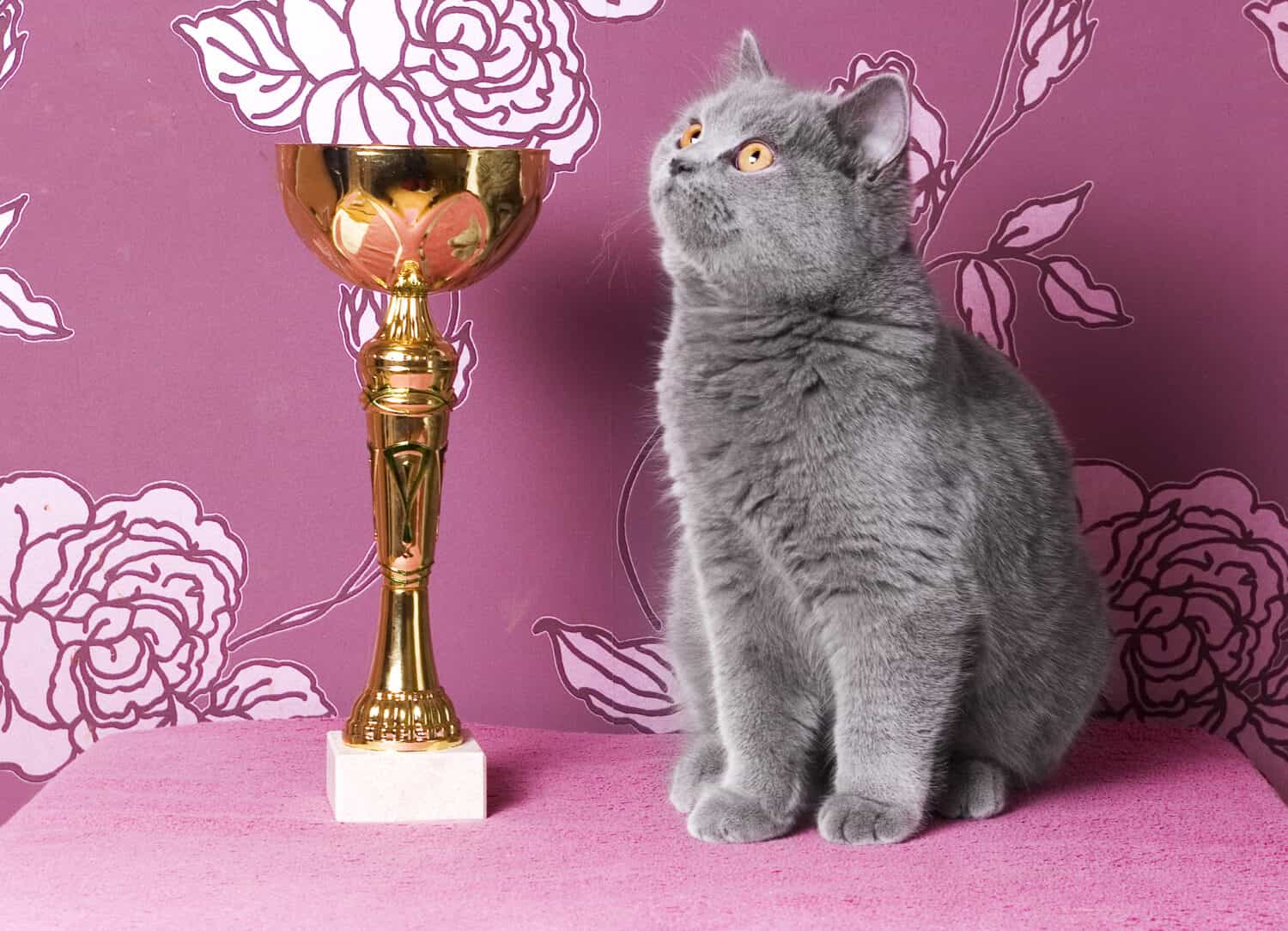
This British shorthair kitten won a trophy at a cat show. Cat shows were started by Harrison Weir.
©Joanna Zaleska/Shutterstock.com
British Shorthair Cat History
One of the first breeds established in the cat fancy, British shorthairs originated in the 1900s. The Romans brought cats from Egypt during their attack on Great Britain. Breeders later bred them with Persian cats around 1914. This gave them their stocky build and rounded features. The mixed breed cats later became the first BSH. Harrison Weir is credited with the creation of the breed as we know it today. The “Father of the Cat Fancy” created the first cat show in 1871.
Around 1918, GCCF placed restrictions on breeding BSH to Persians. This led to a crash in numbers and limited the gene pool. By late 1945, most of the original lines had disappeared. Breeders resorted to crossing the remaining BSHs to domestics, Russian blues, and Persians. By 1979, the breed was flourishing once again. That same year, Brits gained Championship status with TICA. They accepted the longhair variant in 2009. CFA allows British shorthairs but not longhairs.
GCCF states that roughly a quarter of all kittens registered with them each year are BSH. This makes the Brit the most popular cat breed in the United Kingdom. They have never lost the number-one spot with GCCF since they first won it in 1997. As of 2023, they rank at number six with CFA.
Bengal Cat vs. British Shorthair Cat: Health Concerns
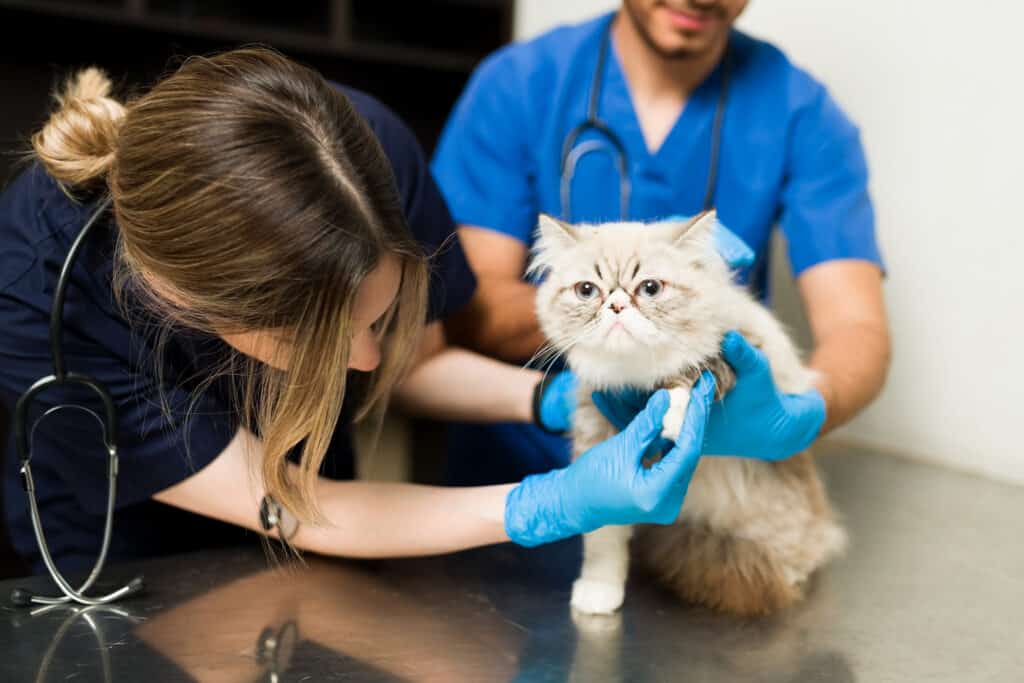
Veterinarian exams are important for any breed of cat.
©Beach Creatives/Shutterstock.com
The health issues associated with these breeds are something to watch out for. Health problems are common in purebred cats and dogs. It is important to find a breeder who understands the issues that can happen. They should also test their cats to reduce the chances of passing on diseases. Some of them could shorten the lifespan of your feline companion. This is not an extensive list by any means. Always research any breed you intend to welcome into your home!
Bengal Cat Health Concerns
Bengal cats generally live 12 to 20 years. They are prone to several health conditions that can reduce their lifespan. The most prominent is hypertrophic cardiomyopathy (HCM). This disease causes the walls of the heart to become thickened. Eventually, this prevents blood from flowing well. This condition can lead to blood clots called feline aortic thromboembolism (FATE). Another health concern, Progressive Retinal Atrophy (PRA), causes blindness. Pyruvate Kinase Deficiency (PK Def) causes red blood cells to die, leaving the cat anemic. Bengals can also have luxating patellas, which means their kneecaps can pop out of place. While not deadly, this condition can be painful.
British Shorthair Cat Health Concerns
British shorthairs have a lifespan between 14 and 20 years. They also have health concerns to think about. Along with Bengals, Maine Coons, and Ragdolls, Brits are prone to HCM and FATE. Another major concern is Polycystic kidney disease (PKD). This condition causes cysts in the kidneys that grow so big they cause the organs to fail. They can also develop cataracts or cloudy lenses in the eyes. This condition is correctable with surgery, but the procedure is expensive. Brits are also at high risk of becoming obese (severely overweight) due to their lazy natures. It is important they get regular exercise. This prevents their joints from carrying extra weight and causing discomfort.
Health Testing for These Cats
HCM requires screening by a veterinary cardiologist each year for breeding cats. That’s because there is no genetic test available yet for Brits or Bengals. PKD and PK Def have genetic tests available that involve a simple mouth swab. Regular veterinary exams and blood work can find other problems. There is no excuse for a breeder not to test for these conditions.
Bengal Cats vs. British Shorthair Cats: Review
Overall, both of these breeds can make wonderful additions to a family. They come from very different pasts, but their unique beauty and personalities make them irresistible! Make sure to research the breeds carefully and find a good breeder if you choose to get one. You can also look into breed-specific rescues that might have a Bengal or a Brit you can adopt. Expect to have the cat as a part of your family for at least 12 years, and prepare to be its forever home. Both breeds love their humans intensely and can become depressed if they get re-homed. Both Bengals and the British shorthairs are incredible cats. Either will bring you much joy and companionship!
The photo featured at the top of this post is ©
Thank you for reading! Have some feedback for us? Contact the AZ Animals editorial team.



